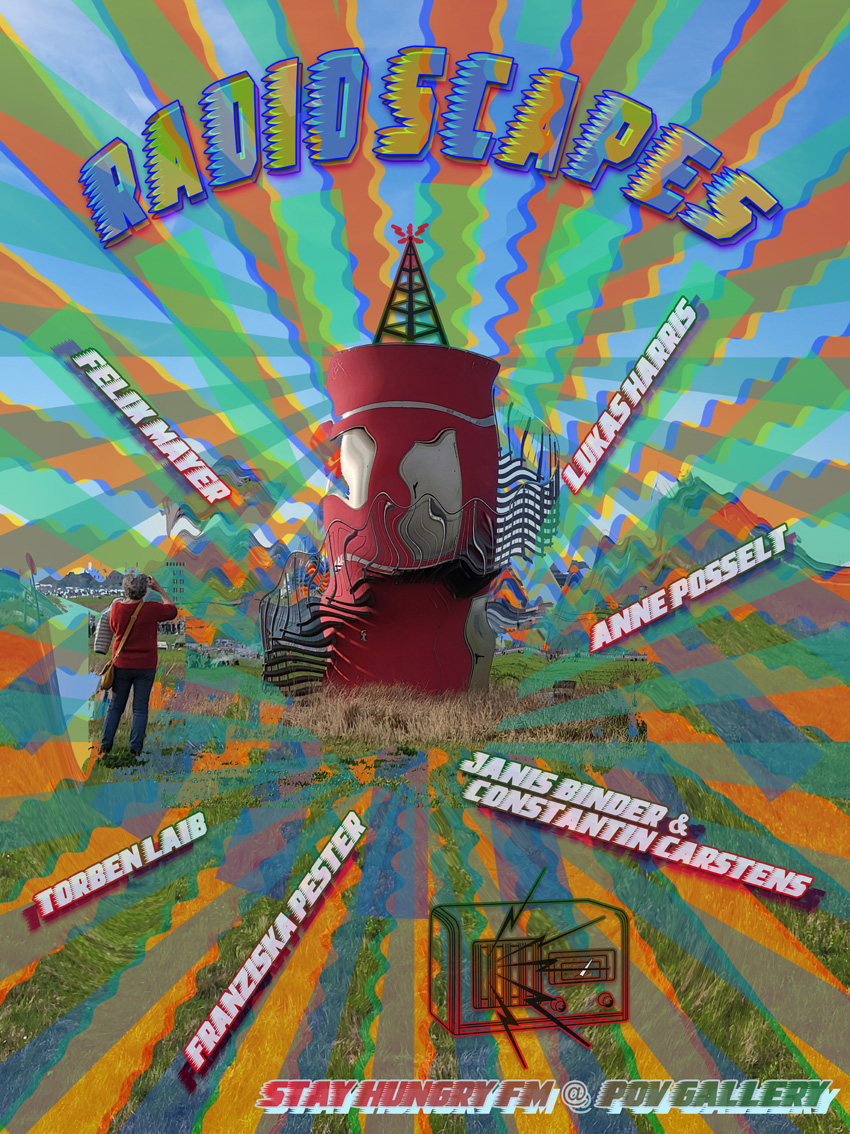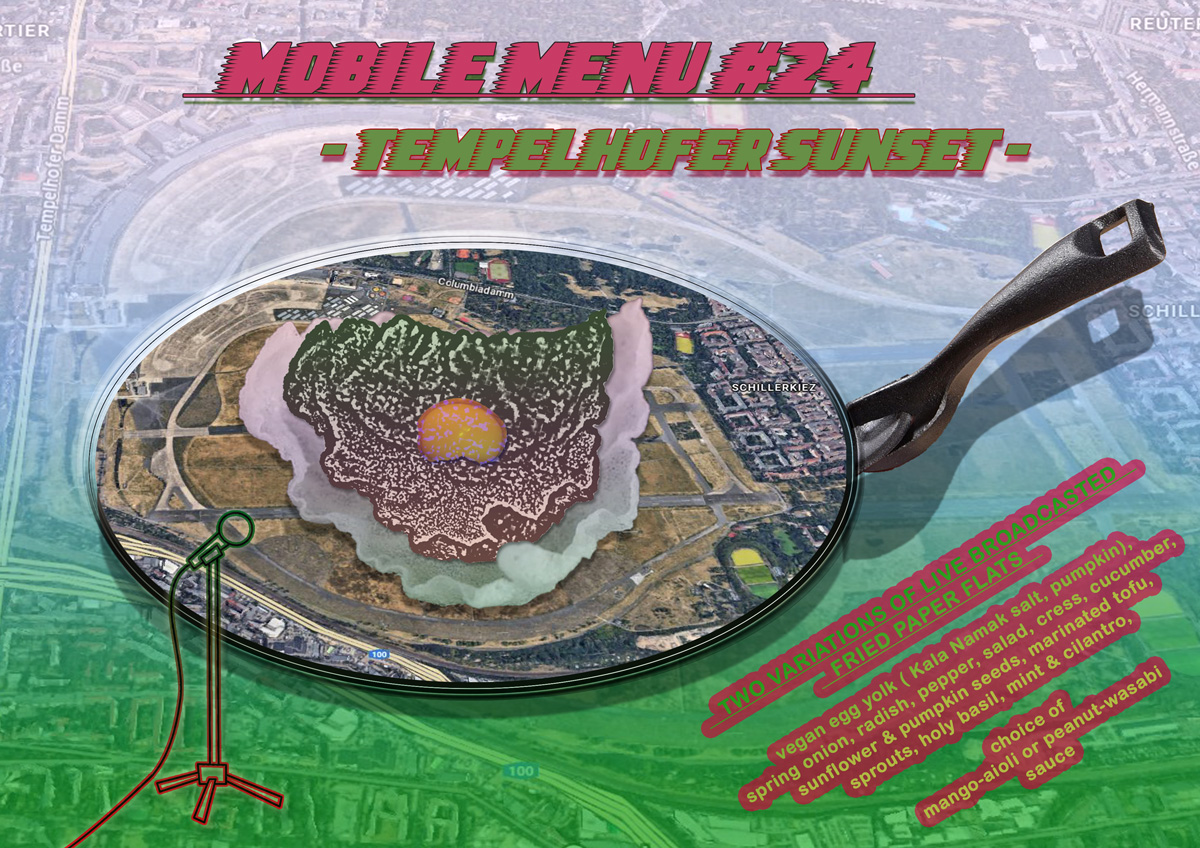
+

stay hungry
presents
RADIO SCAPES
a site-specific sound intervention at Tempelhofer Feld, Berlin
hosted by POV Gallery
with works and contributions by
Torben Laib
Anne Posselt
Lukas Harris
Felix Mayer
Franziska Pester
Janis Binder
Constantin Carstens
Performance program:
4 pm: ICH BIN ALL HIER // Franziska Pester
6 pm: RESONATING PERSPECTIVES // Constantin Carstens & Janis Binder
8 pm: FIELD SCANNER // Torben Laib
Timing:
Saturday, 28.06.25, 2-10 pm
Location:
POV GALLERY @ Tempelhofer Feld/ Berlin
Click here for exact location on maps
Geodata : 52.466528, 13.400088 or FC82+J2 Berlin
Instagram: stay_hungry_project_space
POV Gallery Homepage
https://www.wrgstudios.de/
https://48-stunden-neukoelln.de/de/programm/radio-scapes
RADIO SCAPES
The Tempelhofer Feld in Berlin is not only a place of vast open space, but also an acoustic environment of possibility. Open and permeable like few other places in the city, it brings voices, sounds and movements into new constellations. Sounds lose their direction here, overlap, disappear and reemerge. The open terrain acts like a giant amplifier, making the environment audible and forming an urban echo field that interweaves nature and city as well as history and the present.
At the same time, the Tempelhofer Feld is a politically charged space. It stands for collective use and urban participation but is also threatened by control, exclusion and displacement. Its openness is the result of years of civil society debates and is once again under threat. The Berlin Senate is pursuing development plans that would fundamentally change the character and social structure of this unique site.
The history of the site is equally complex. As a former airport, Tempelhof was a place of military activity, forced labor but also Western symbolic politics. During the division of Germany, it was one of the few points of access to West Berlin. Visible and invisible borders such as district lines, fences and transit paths still traverse the field today. It remains a space of transitions and ongoing overwriting.
Against this backdrop, RADIO SCAPES understands the Tempelhofer Feld as a transmission space, where acoustic, historical and political impulses intersect and merge. The spatial basis for this is formed by the red tower at the southern end of the field, which is the base of POV Gallery, a new project and exhibition space with a focus on Eastern European art and culture. With its cylindrical architecture and open rooftop platform, the tower resembles an abandoned transmitter mast. For RADIO SCAPES, it becomes the starting point for sonic explorations and a temporary broadcasting station in public space.
RADIO SCAPES is conceived as an imaginary radio program without a set frequency — not linear, not moderated, but as an open, space-related choreography of sound, performance and intervention. A collective and porous program emerges, responsive to resonance, interference, gaps and randomness. At its core stands the idea of transmission, the principle behind radio technology itself: the inaudible is made audible and visible. Movements, oscillations, thoughts and stories are translated into sound.
The exhibition features works by seven artists from the collective of the association WRG Studios e.V. from Braunschweig, Torben Laib, Felix Mayer, Janis Binder, Constantin Carstens, Franziska Pester, Anne Posselt, and Lukas Harris. Their practices engage with sound, acoustic perception and the potentials of transmission.
The intervention will be accompanied audio-culinray by Mobile Menu #24. RADIO SCAPES is part of 48 Stunden Neukölln and will take place on Saturday, 28.06.2025, 2-10 pm.
***
RADIO SCAPES is a project by stay hungry in collaboration with POV Gallery Berlin, and is part of the WRG KOMPLIZ exhibition exchange format. KOMPLIZ invites operators of independent project spaces to exhibit in WRG SENSOR in Braunschweig, In return, the invited project space invites artists from the collective from Braunschweig to realize an exhibition in their project space in another city. After stay hungry's visit to Braunschweig in December 2024, the Braunschweig collective now returns the visit in Berlin.

* deutsche Version
RADIO SCAPES
Das Tempelhofer Feld in Berlin ist nicht nur ein Ort der Weite, sondern ein akustischer Möglichkeitsraum. Offen und durchlässig wie kaum ein anderer Ort in Berlin, bringt es Stimmen, Geräusche und Bewegungen in neue Konstellationen. Klänge verlieren hier ihre Richtung, überlagern sich, verschwinden und tauchen wieder auf. Die Fläche wirkt wie ein riesiger Verstärker, der Umwelt und Umgebung hörbar macht und ein urbanes Echofeld bildet, das Natur und Stadt, Geschichte und Gegenwart miteinander verschränkt.
Gleichzeitig ist das Tempelhofer Feld ein politisch aufgeladener Ort, der für gemeinschaftliche Nutzung und urbane Teilhabe steht, aber auch durch Kontrolle, Abgrenzung und Verdrängung gefährdet ist. Seine Offenheit ist das Ergebnis langjähriger zivilgesellschaftlicher Auseinandersetzungen und steht heute erneut unter Druck. Der Berliner Senat plant Bebauungen, die den Charakter und die soziale Struktur dieses besonderen Raums grundlegend verändern könnten.
Auch die Geschichte des Geländes ist vielschichtig. Als ehemaliger Flughafen war Tempelhof ein Ort militärischer Präsenz, Zwangsarbeit aber auch westlicher Symbolpolitik. Während der deutschen Teilung war er eine der wenigen Zugangsmöglichkeiten nach West-Berlin. Sichtbare und unsichtbare Grenzen wie Bezirkslinien, Zäune und Wege durchziehen das Feld bis heute. Es bleibt ein Raum der Übergänge und der kontinuierlichen Überschreibungen.
Vor diesem Hintergrund versteht RADIO SCAPES das Tempelhofer Feld als Senderaum – als einen Raum, in dem akustische, historische und politische Signale aufeinandertreffen und sich vermischen. Die räumliche Grundlage dafür bildet der rote Turm am südlichen Ende des Feldes, in dem sich die POV Gallery befindet, ein Projekt- und Galerieraum mit Fokus auf osteuropäische Kunst und Kultur. Mit seiner zylindrischen Architektur und der offenen Plattform wirkt der Turm wie ein stillgelegter Sendemast. Für RADIO SCAPES wird der rote Turm zum Ausgangspunkt für klangliche Erkundungen und zur temporären Sendestation im öffentlichen Raum.
Dabei ist RADIO SCAPES als imaginäres Radioprogramm ohne Frequenz gedacht – nicht linear, nicht moderiert, sondern als offene, raumbezogene Choreografie aus Klang, Performance und Intervention. Es entsteht ein kollektives, durchlässiges Programm, das offen bleibt für Impulse, Störungen, Pausen und das Zufällige. Im Zentrum steht die Idee der Übertragung – jenes Prinzip, das auch Radiotechnologie zugrunde liegt: Nicht-Hörbares wird hör- und sichtbar gemacht. Bewegungen, Schwingungen, Gedanken und Geschichten werden in Klang übersetzt.
Die Ausstellung RADIO SCAPES präsentiert Arbeiten von sieben Künstler_innen aus dem Kollektiv des Vereins WRG Studio e.V. aus Braunschweig, Torben Laib, Felix Mayer, Janis Binder, Constantin Carstens, Franziska Pester, Anne Posselt und Lukas Harris, deren Arbeiten sich im weitesten Sinne mit Klang, akustischer Wahrnehmung und Formen der Übertragung auseinandersetzen.
Die Intervention wird vom Mobile Menu #24 audio-kulinarisch begleitet. RADIO SCAPES findet als Teil von 48 Stunden Neukölln am Samstag, den 28.06.2025 von 14-22 Uhr statt.
***
RADIO SCAPES ist ein Projekt von stay hungry in Kollaboration mit POV Gallery Berlin und ist Teil des Ausstellungsformat WRG KOMPLIZ, das Betreiber_innen von Projekträumen einlädt, ihre Arbeiten im WRG Sensor in Braunschweig in einer Ausstellung zu präsentieren. Im Gegenzug lädt der eingeladene Projektraum Künstler_innen des Kollektivs aus Braunschweig ein, um eine Ausstellung in ihrem Projektraum in einer anderen Stadt zu realisieren. Nach dem Besuch von stay hungry in Braunschweig im Dezember 2024 folgt nun der Gegenbesuch des Künstler_innenkollektivs aus Braunschweig in Berlin.
